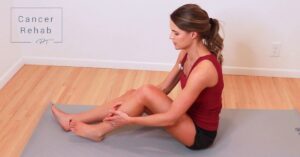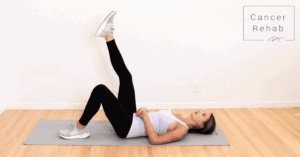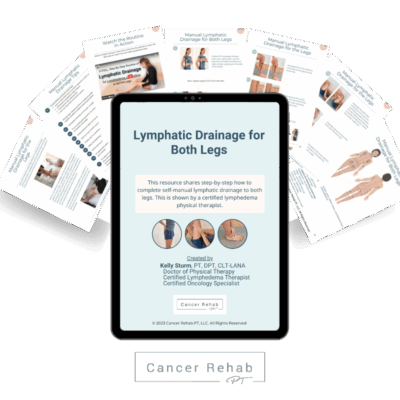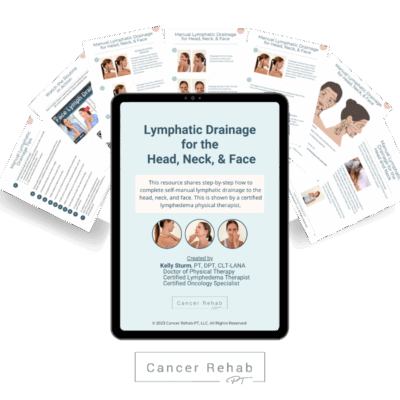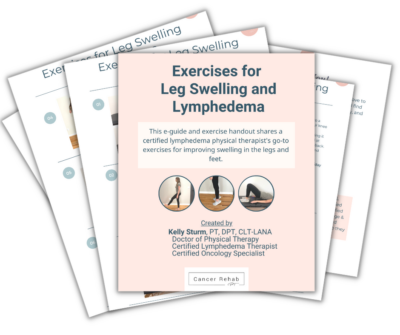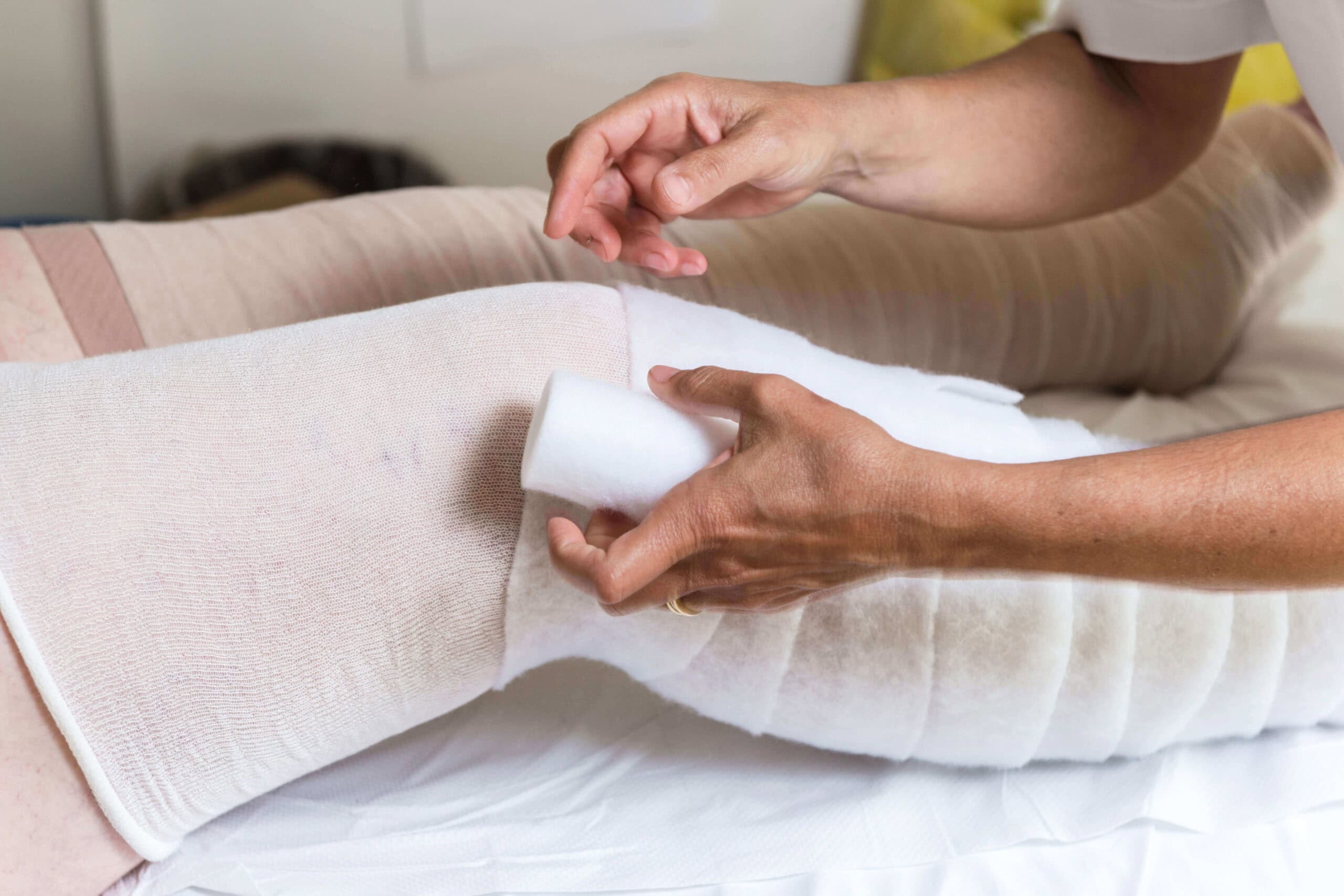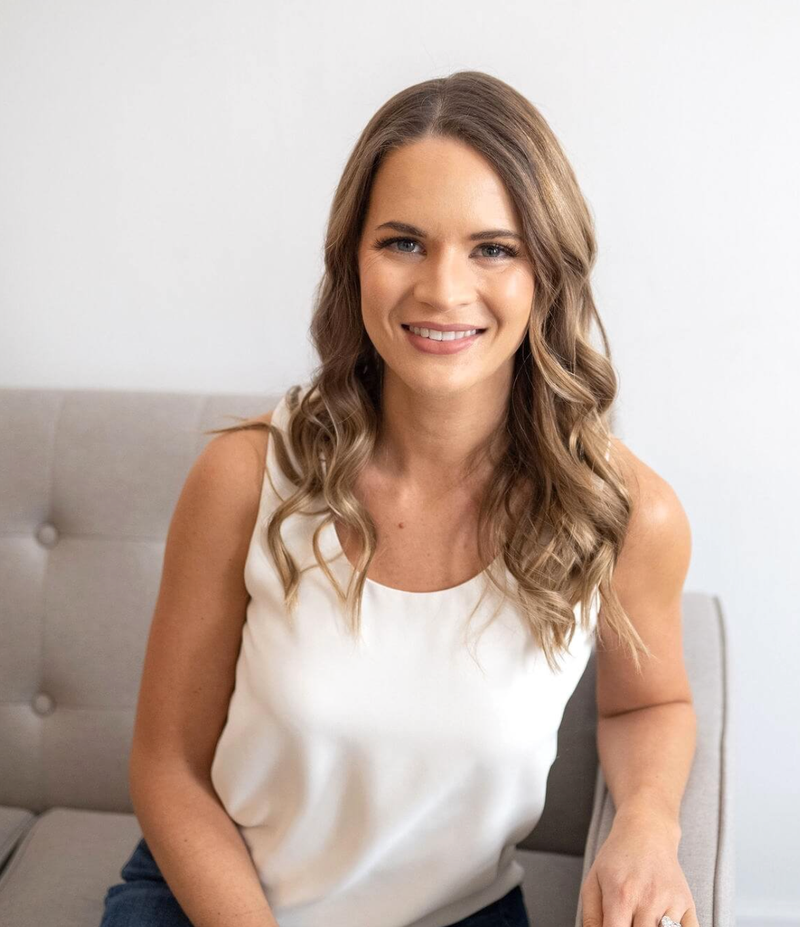Lymphedema causes fluid buildup and swelling in different parts of the body, most commonly in the arms and legs. It’s a chronic condition without a known cure, but physical therapy for lymphedema can help you effectively manage symptoms and live a healthy life.
Most importantly, you don’t have to accept pain, swelling, and discomfort as your new normal. This is what many people are told, and it couldn’t be further from the truth.
In my 10+ years of experience as a Certified Lymphedema Therapist, I’ve seen thousands of people minimize symptoms of lymphedema and maximize their lives. You can find more support in Lower Body Lymphedema Rehab and Breast Cancer Rehab.
What Is Lymphedema?
Lymphedema develops when your lymphatic system becomes unable to effectively drain lymph fluid. This leads to lymph fluid buildup in certain parts of your body, most often in your arm or leg.
As a result, you start noticing lymphedema symptoms such as swelling, discomfort, and pain. It can become difficult to lift your arm, walk, or go about your regular daily tasks. Lymphedema often develops after cancer treatment.
There are two types of lymphedema:
- Primary Lymphedema: Caused by inherent malformations of the lymphatic system (AKA, it’s something you’re genetically predisposed to or are born with).
- Secondary Lymphedema: Results from damage to the lymphatic system, often after surgery, radiation therapy, infection, injury, and cancer treatments.
Primary lymphedema is rare, but secondary lymphedema is one of the most common chronic diseases in the world. Research estimates that up to 250 million people1 worldwide have lymphedema.
Physical Therapy for Lymphedema: What It Is & How It Works
Whether you’ve been living with lymphedema for many years or have just started developing the condition, there are many forms of effective lymphedema treatment to manage unpleasant symptoms.
Physical therapy for lymphedema includes:
- Physical exercise program
- Compression therapy
- Manual Lymphatic Drainage (MLD)
- Skincare
- Lymphedema self-care
Your medical provider may refer to this regimen as Complete Decongestive Therapy or CDT.
Lymphedema therapy has two phases: an Active Phase (Phase 1) and a Maintenance Phase (Phase 2).
During the Active Phase, the focus is on intensive treatment to reduce the swelling as much as possible. This typically involves manual lymphatic drainage (MLD) sessions, compression bandaging, and an exercise program with a physical therapist.
In the Maintenance Phase, you continue to follow your lymphedema management plan on your own to maintain your results.
If you don’t have access to a physical therapist or feel like you need more support at an accessible price point, learn more about Lower Body Lymphedema Rehab and Breast Cancer Rehab (for lymphedema after breast cancer treatment).
Why Exercise Helps Treat Lymphedema
Physical exercise is one of the most important parts of lymphedema treatment. When you move your body, your muscles contract and act as a natural pump for the lymphatic system. It makes it easier for your lymph vessels to drain lymphatic fluid out of swollen areas.
It doesn’t matter what type of exercise you do, as long as it’s something you can stay consistent with. Walking, biking, swimming, yoga, and other low-impact activities are great.
You can also try these lymphedema leg and lymphedema arm exercises.
Exercises for Arm and Chest Swelling
1. Shoulder Roll
Stand straight and roll your shoulders in large circles. You can do 10-15 rolls in one direction and then switch it up. This exercise may seem simple, but it stimulates lymph nodes around your collarbone area, ears, and armpits.
2. Shoulder Raises
Stand straight and bring your arms right in front of you and over your head. Come back down with control. Then raise your arms to the side, going all the way overhead, and come back down. Repeat 10-15 times.
If you have any shoulder pain, you can modify this exercise and only raise your arms as high as it feels comfortable.
3. Bicep Curls
You can do these with no weight or low-weight dumbbells, such as 1 pound. Bending at your elbow, bring your hand up towards your shoulder while keeping your elbows at your sides.
It’s key to make sure that you have control on the way down. This is a good and simple way to get your muscles pumping and support your lymph flow. Repeat 10-15 times.
I share more exercises for arm lymphedema in my program Breast Cancer Rehab!
Exercises for Leg Lymphedema
1. Bridges
Lay on your back with your knees bent. Engage your core and gently move your pelvis up a few inches. Go back down with control, keeping your core engaged. Repeat 10-15 times.
2. Leg Raises
Lay on your back with one leg straight and one leg bent at the knee. Keep your core engaged and your back flat. Lift your leg and lower it back down, maintaining control. Try not to arch your back, repeat 10-15 times, and switch legs.
3. Heel Slides
Lay on your back with your knees bent. Slide your heel down and move it back up. This activates your muscles in the thigh, below the knee, and in your calf. Repeat 10-15 times and switch legs.
More Lymphedema Exercises
If you want to print out lymphedema exercises to do them at home, I have helpful digital guides:
- Exercises for Leg Swelling and Lymphedema
- Exercises for Arm and Chest Swelling and Lymphedema
- Exercises for Head and Neck Swelling and Lymphedema
Remember that treating lymphedema is all about consistency.
Pick a form of physical exercise that you like and can stay consistent with, and try to move your body every day, even if it’s just for a few minutes!
Compression Therapy
Compression therapy is one of the most important parts of lymphedema treatment. It works by using compression garments, such as sleeves or stockings, to help move excess fluid out of the affected area and prevent buildup.
These garments apply a controlled amount of pressure to the limb and encourage the lymphatic fluid to flow toward areas with functioning lymph nodes and vessels so it can get properly drained. Browse compression therapy products I love and trust!
Manual Lymphatic Drainage (MLD)
Manual Lymphatic Drainage (MLD) is a special massage technique that helps stimulate the flow of lymph fluid. Certified Lymphedema Therapists apply gentle, rhythmic pressure in a specific direction to make the fluid move from the swollen area to healthier regions.
If you don’t have access to a Certified Lymphedema Therapist, you can learn how to do MLD yourself with my digital guides:
- Head, Neck, and Face Manual Lymphatic Drainage
- Both Legs Manual Lymphatic Drainage
- Left Leg Manual Lymphatic Drainage
- Right Leg Manual Lymphatic Drainage
- Both Arms Manual Lymphatic Drainage
- Right Arm Manual Lymphatic Drainage
- Left Arm Manual Lymphatic Drainage
Manual lymph drainage is an effective way to reduce swelling, discomfort, and aching.
Skin Care
Proper skin care helps prevent infections, which can make lymphedema worse. It’s important to:
- Keep your skin clean and moisturized
- Often check for signs of infection or injury
- Avoid cuts, scrapes, burns, and other skin injuries – even minor ones
- Use insect repellent and sunscreen
In general, be careful with your skin. When you’re living with lymphedema, even minor injuries can lead to infections like cellulitis.
FAQs
Will Physical Therapy Help with Lymphedema?
Yes, physical therapy helps reduce swelling, improve mobility, and prevent lymphedema from getting worse. Physical therapy for lymphedema typically includes physical exercises, Manual Lymphatic Drainage (MLD), skincare, and self-management routines you can do at home. Lymphedema is a chronic disease with no known cure, but building an effective physical therapy routine can help you minimize – or even reverse – lymphedema symptoms.
What Is the Best Exercise for Lymphedema?
There isn’t a single “best” exercise for lymphedema. Most forms of movement are helpful, as long as they’re low-impact and don’t lead to injury. Walking, swimming, biking, and yoga are great options. I also share many targeted lymphedema exercises in my programs Breast Cancer Rehab (for arm and chest lymphedema) and Lower Body Lymphedema Rehab. Most importantly, the best exercise for lymphedema is an exercise that you enjoy and can stay consistent with.
Can Exercise Reverse Lymphedema?
Lymphedema is a chronic disease, so it’s typically not possible for exercise to completely reverse lymphedema. However, consistent exercise can significantly reduce swelling and improve symptoms. For early-stage lymphedema, regular physical therapy may be able to reverse lymphedema.
What Should You Not Do with Lymphedema?
If you have lymphedema, you should avoid activities that make your swelling worse. While different people have different triggers, typically you should avoid sitting/standing without movement for a long time, tight clothing or accessories (this is different from wearing specialized compression garments), and exposure to extreme temperatures.
Get More Support in Lower Body Lymphedema Rehab
Physical therapy for lymphedema helps you reduce uncomfortable symptoms and start living your life more fully.
However, many people feel like they don’t get enough support from their medical providers or don’t have access to physical therapists. In my practice, I’ve seen people who’ve been living with lymphedema for 20+ years and never had access to high-quality education on how to manage their symptoms.
This is why I created my online programs, Lower Body Lymphedema Rehab and Breast Cancer Rehab. Inside, you’ll find exercises, self-care routines, and techniques that help you reduce swelling and start living a healthier life.
Article Sources
- The Lymphatic Education & Research Network ↩︎

